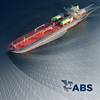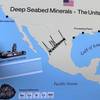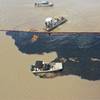Infrastructure for Alaska’s LNG and Other Resources
Trans Arctic Shipping Routes (TASR)
It is time for the global maritime industry to push development of Trans Arctic Shipping Routes (TASR) and port facilities along Alaska’s northern coast. Not only for shipping goods from the Pacific to Atlantic and vice versa, but specifically to facilitate development of specialized ports for LNG exports from Alaska to global markets.
Alaska has a limited maritime community mostly in the south: Southeast Alaska is a maritime community; South Central, Valdez, The Kenai Peninsula and Anchorage much less so; Southwest Alaska and Aleutians have fishing fleets and the Western, North Slope coasts and, the Interior have only marginal connections to large scale maritime activities. Nearly all Alaska’s vast energy resources, LNG and coal, are on the North Slope.
Today in Alaska there is a heated debate over LNG pipeline routing, as all scenarios call for LNG pipelines from the North Slope to Valdez (for export) or Anchorage for electricity production, domestic heating and in-state industrial use. To my knowledge, no studies of impacts of increased ship traffic into the small Port of Valdez or the limited Port of Anchorage have been done.
Both proposals call for an 800-mile pipeline: One, a large diameter high-pressure pipeline to Valdez, the other, a smaller, low-pressure line to Anchorage with a possible spur to Fairbanks. And, separately, there is a proposed gas conditioning plant on the North Slope for a trucking operation to bring heating fuel to Fairbanks.
Under either scenario, not all regions of Alaska share in utilization of North Slope LNG which is in conflict with Alaska’s economic construct as an ”Owner State,” wherein all parts of Alaska are accorded equal benefit from Alaska’s natural resources.
Developing maritime infrastructure on the North Slope will facilitate development of the TASR and transit across the Arctic Basin between the Pacific and Atlantic and it should be part of the debate. Thinning arctic ice, purpose built ships and specialized port facilities for exporting LNG from North Slope tidewater to world markets would establish an anchor for commerce across the TASR. For the Alaska’s LNG producers and the state, a North Slope LNG export facility makes economic sense for all. Exporting LNG directly from the North Slope eliminates 800 miles of pipeline and about $50 billion in development costs. It also creates a revenue stream for the producers and the state faster.
For Alaska’s residents, North Slope LNG Export means a more rapid distribution of resource revenue to them, and developing Alaska’s North Slope LNG export infrastructure does not impair additional development of in-state energy, domestic heating or industrial use through appropriately sized LNG pipeline projects.
As background, in 1992 I joined an Alaskan delegation to Finland for the International North Sea Routes Conference hosted by the Finnish Foreign Trade Association, The Finnish-American Chamber of Commerce and the State of Alaska. My interest was development and financing a transshipment cargo port at Dutch Harbor in the Aleutians.
In preparation, I gathered National Oceanic and Atmospheric Administration (NOAA) charts and polar maps and read volumes of reports. Delegation members also made an inventory of Alaskan products for export and products being shipped between the Pacific and Atlantic via the Panama Canal. Also studied were statistics on products shipped from Europe to Asia via Suez Canal or around the Capes.
In doing so, we came to believe the TASR offered an opportunity for the global shipping dynamic: vastly shorter distances offer shorter port-to-port transit times that will potentially amount to hundreds of billions of dollars in reduced operating costs and saving to clients, not to mention reduced energy use, emissions as well as less exposure to disasters inherent on current routes.
Weather and ice conditions do present formidable challenges. We also learned other Arctic nations had more focus on the Arctic than the U.S., and that Alaska had no authority to create or operate the TASR. Finland was building icebreakers and assisting Russia with the Shtokmanovskoye Gas Prospect in the Barents Sea. And as we grew familiar with the Shtokmanovskoye Project, we realized Alaska’s resources had commercial volumes of natural gas that could support creating necessary LNG conditioning, pipeline and loading facilities on the North Slope. Not to mention the potential of exporting the Point Lay High-BTU, Low-Sulfer, low ash exportable “clean” coal. We toured icebreakers, reviewed remote sensing technologies capable of providing real time analysis of ice conditions and we visited facilities that simulate ice conditions on ships. With all this enhanced knowledge, we became convinced of the technical ability to construct purpose built ships (see attached student drawn SWATH concept drawing below) and loading facilities suited for the TASR.
We envisioned a “mirror” development to the Shtokmanovskoye project in Alaska. Instead of bringing natural gas onshore for conditioning and shipment south, Alaska’s natural gas (and high BTU, low sulfer coal) could be sent offshore three to five miles through a pipelines inside sub-surface tunnels to loading platform where purpose built Very-Large Ice-Classed LNG Ships could transport the gas to markets in Asia or Europe. We were confident of the Finnish shipbuilders experience and ability to build the ships.
With this knowledge we returned to Alaska and presented the possibilities. Unfortunately, interest in exporting LNG via the TASR waned as then Governor Hickel left office and a new Environmental Industry backed anti-development administration took control.
Fast forward 20 years and technology has advanced non-stop, from computers and communication to LNG transportation and distribution. In maritime LNG transportation, Submerged Turret Loading (STL) Buoys and Icebreaking Offshore Facilities exist. Tunnel Boring Machines (TBM’s) can tunnel the sub-sea floor, eliminating many environmental impacts, and, the development can be done at a considerably lower cost than a $70 billion dollar large-diameter line proposed from the North Slope to Valdez or Anchorage.
In October 2012, The TransCanada Corporation proposed a rerouted project to Anchorage and detailed it to Alaska’s Governor Parnell. The update reportedly claims it will cost about $70 billion for a North Slope gas treatment, conditioning plants, and 800-mile pipeline to Southcentral Alaska including a LNG storage facility and tanker terminal to export 15 to 18 million metric tons of LNG annually.
The 800-mile pipeline is only one element of total cost, as an over the life of the pipeline to a southern tidewater, numerous costs will be imposed: A per mile fee for maintenance, remediation, etc., will be paid to the pipeline’s owners as rent for the line and all that will far exceed the cost anything anticipated for a three to five mile sub-seafloor pipeline to Arctic tidewater.
In every scenario, ships must be built.
A Q-max sized LNG ship at 1132 x 177 ft. carries about 266,000 cu. m. tons of LNG and costs $200-300 million to build To export LNG from the North Slope, 10 to 15 purpose-built ships must be constructed for between $2b and 4.5b. Even with that cost added to the North Slope export facilities, the estimated development should be $50b less than crossing Alaska to Anchorage, and the timeline is compressed.
Most importantly for Alaskans, the differential capital cost between proposed pipelines going south, plus facilities and ships and, TASR North Slope LNG export will be significant. On the surface it is $50b, ample capital to fund both in-state domestic gas heating distribution systems as well as, a full spectrum of in-state industrial developments when practical and profitable.
So, does the TASR development benefit Alaskans more than 800-mile pipeline south? In a word, yes. Alaska’s leaders say Alaska’s resources belong to “us,” the people. However in reality, Alaska’s resources belong to the State and the State is mandated to manage them for the highest benefit of the Alaskan people. If that is correct, then producing resource revenues for less cost on a shorter schedule brings the highest benefit.
(As published in the June 2013 edition of Maritime Reporter & Engineering News - www.marinelink.com)










